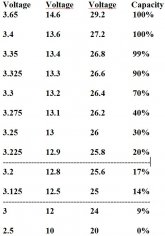peterwareing
New Member
- Joined
- Dec 4, 2019
- Messages
- 23
This may be a silly question. I have a hybrid solar / charge controller / grid tie / 48v LIFEPO4 battery system.
I have used various charge parameters - currently sticking with 55.6v charging and 54.4v float.
I read that when the charging is in float mode the inverter takes the power directly from the solar panels.
If this is the case - this must reduce the charging / discharging losses encountered with batteries.
So is there any benefit in reducing the charging voltage to the same as the float voltage 54.4 (3.4v per cell).
I have read that any voltage above 3.4v is hard to access and provides little benefit?
Any advice gratefully received.
I have used various charge parameters - currently sticking with 55.6v charging and 54.4v float.
I read that when the charging is in float mode the inverter takes the power directly from the solar panels.
If this is the case - this must reduce the charging / discharging losses encountered with batteries.
So is there any benefit in reducing the charging voltage to the same as the float voltage 54.4 (3.4v per cell).
I have read that any voltage above 3.4v is hard to access and provides little benefit?
Any advice gratefully received.



